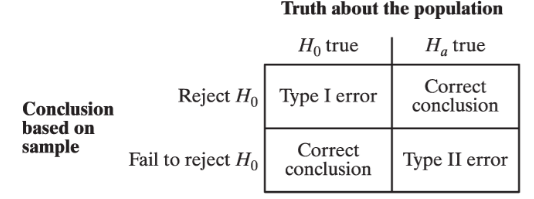AP Stats Section 2 (unit 6-12)
All the mathy things in AP stats
Experimental Designs
Completely Randomized

Randomized Block

Matched Pairs

Probability Models/Rules
Two-Way Tables

Venn Diagram

Equally Likely Outcomes:
P(A) = Number of outcomes in event A / Total number of outcomes in sample space
Complement Rule: P(Ac ) = 1 - P(A)
Addition Rule for Mutually Exclusive Events: P(A or B) = P(A) + P(B)
General Addition Rule: P(A or B) = P(A) + P(B) - P(A n B)
Conditional Probability: P(A | B) = P(A n B) / P(B)
General Multiplication Rule: P(A and B) = P(A n B) = P(A) x P(B | A)
Multiplication Rule for Independent Events: P(A and B) = P(A n B) = P(A) x P(B)
Transforming and Combining Random Variables
Continuous Random Variables: Can take any value in an interval on the number line.
E(x) = x1p1 + x2p2 + x3p3
σ2 = (x1 — μ1)2p1 + (x2 — μ2)2p2 + (x3 — μ3)2p3
Linear Transformations
Rule for Means: μa+bX = a+b(μx)
Rule for Variances: σ2a+bX = b2σ2x
x must be a constant
adding/subtracting doesn’t change measures of variability (range, IQR, SD), or shape of the probability distribution. It does change measures of center and location (mean, median, quartiles, percentiles).
Multiplying/dividing changes measures of center and location and measures of variability, but not the shape of the distribution.
Comparing Independent Random Variables
Where difference is D = X - Y and the sum is S = X + Y
Rules for combining means:
μD = μX - Y = μX - μY
μS = μX + Y = μX + μY
Rules for combining variances:
σ2D = σ2X - Y = σ2X + σ2Y
σ2S = σ2X + Y = σ2X + σ2Y
Where there is a linear transformation difference is D = bX - cY and the sum is S = bX + c
Rules for combining means:
μD = μbX - cY = bμX - cμY
μS = μbX + cY = bμX + cμY
Rules for combining variances:
σ2D = σ2bX - cY = b2σ2X + c2σ2Y
σ2S = σ2bX + cY = b2σ2X + c2σ2Y
Binomial Distributions (6.3)
Necessary Settings:
Binary? - outcomes can be classified as “success” or “failure”
Independent? - knowing the outcome of one trial doesn’t tell anything about the outcome of another trial
Number? - the number of trials of the random process is fixed in advance
Same Probability? - there is the same probability of success in each trial
the Binomial Coefficient - the number of ways to arrange x successes among n trials
nCr → [Math] [Prob] [3]
! → [Math] [Prob] [4]
Precise Functions
binompdf (n, p, x) → [2nd] [Vars] [A]
Continuous Functions
binomcdf (n, p, x) → [2nd] [Vars] [B]
P( x < 3 ) = p( x = 0 ) + p( x = 1 ) + p( x = 2 )
expected count of successes:


As the sample size becomes larger, the Binomial Distribution becomes more like a Normal Distribution. If the following conditions are fulfilled then the sample size is large enough to consider the distribution normal:
10% condition
Large Counts Condition: at least 10 expected successes and 10 expected failures
Geometric Distributions (6.4)
If an experiment has two possible outcomes of success (p) and failure (1-p), and the trials are independent.
The probability that the first success is on trial number k:
P(X = k) = ( 1- p)k-1p
P(X = k) →geometpdf → [2nd] [Vars] [F] → (prob, x-value)
P(X ≤ k) →geometpdf → [2nd] [Vars] [G] → (prob, x-value)

Sampling Distributions
Sampling Distributions of p hat
7.2
Sampling Distributions of x bar
7.3
Confidence Intervals
use t* or z*
Confidence Intervals 1-prop
8.2
Confidence Intervals for p1-p2
8.3
Confidence Intervals for U (mew)
10
confidence interval for a difference between two means (two-samp)
10.2
confidence interval for U diff (paired)
10.2
t-interval for the slope
12.3
Significance Tests
About a Proportion - 1-prop (9.2)
One sided
S: H0 : p = p0
Ha : p > p0 -or- Ha : p < p0
P: One sided z-test for p̂
Random: The data comes from a random sample from the population of interest.
10%: when sampling without replacement, n < 0.1N
Large Counts: Both np0 and n( 1 - p0) are at least 10
D:
P(p < p0) →normcdf → [Stat] [tests] [5] → (-1e99, z, 0, 1)
P(p > p0) →normcdf → [Stat] [tests] [5] → (z, 1e99, 0, 1)
C: Because our p-value of p < a = 0.05, we reject H0 . We have convincing evidence that…
Two sided
S: H0 : p = p0
Ha : p ≠ p0
P: Two sided z-test for p̂
D: P(p ≠ p0) →normcdf → [Stat] [tests] [5] → (-1e99, z, 0, 1)x2
interpret the p-value - “assuming H0 is true, there is a p probability of getting a sample mean of ___ by chance alone in a random sample of n.”
Power
the probability that the test will find convincing evidence that Ha is true when H0 is true.
interpret - “If the true proportion of population is p0 , there is a power probability of finding convincing evidence that Ha : p < p0 is true.”

Power increases when:
the sample size n is larger
the significance level a is larger
the null and alternative parameters are further apart
About a Difference in Proportions - 2-prop (9.3)
significance test about a mean
11
significance test with a difference in means (2-samp)
11.2
significance test about U diff (paired t-test)
11.2
significance test for the slope
12.3
X2 Test for Goodness of Fit (12)
12
test for homogeneity
11.2
test for independence/association
11.2